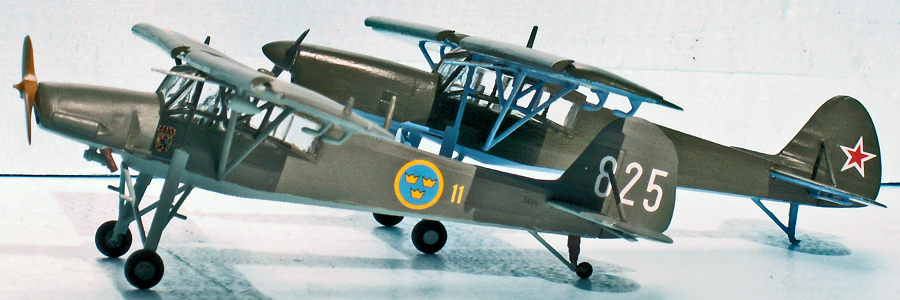
| KIT #: | 072/l72211 |
| PRICE: | $20.00 each |
| DECALS: | 12 + 2 options |
| REVIEWER: | Torben Plesberg |
| NOTES: |

| HISTORY |
The Fieseler Storch was designed and built by Fieseler Flugzeugbau G.m.b.H., headed by Gerhard Fieseler, the famous German aerobatic pilot, who scored 22 victories as a fighter pilot during WWI. The specifications was for a multi-purpose communication aircraft with 2-3 seats and to exploit the latest aerodynamic high-lift devices, which would provide extreme STOL capabilities.
The first flight of the prototype Fi 156 took place early in 1937. The aircraft revealed extraordinary STOL characteristics. It would take off after a ground run of only 15 m at 35 mph. A prepared landing strip of 130 m was sufficient to clear a 15 m obstruction and land the aircraft –the actual ground run being less than 40 m with maximum braking.
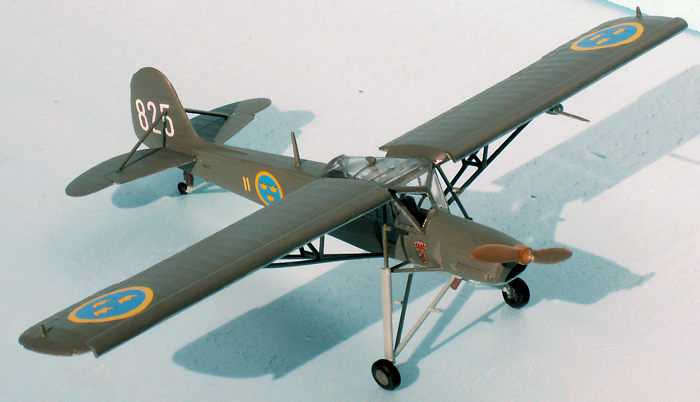 The secret
of the extraordinary STOL performance of the Storch is the wing construction and
the extra long oleos of the main landing gear. The wing has full span fixed
slats and slotted flaps for maximum lift. The Storch is a high wing monoplane
with an extensively glazed cockpit, looking like a green house, powered by a 240
HP 8 cylinder inverted Vee Argus engine.
The secret
of the extraordinary STOL performance of the Storch is the wing construction and
the extra long oleos of the main landing gear. The wing has full span fixed
slats and slotted flaps for maximum lift. The Storch is a high wing monoplane
with an extensively glazed cockpit, looking like a green house, powered by a 240
HP 8 cylinder inverted Vee Argus engine.
The Storch was an immediate success, and it was ordered by the Luftwaffe, in substantial numbers. The RLM declared the aircraft free for export, and the first customer showing interest was the Swedish Air Force – Flygvapnet.
The Storch in Swedish service: Two aircraft were ordered, and arrived in Sweden in the summer 1938. They got the designation P-4, meaning Provflygplan 4 –test aircraft 4. The Storchs were tested extensively by F 3 at Malmslätt (Malmen), and later an order for additional 6 aircraft was placed with the Fieseler Flugzeugbau G.m.b.H. during 1939.
These 6 aircraft were delivered unassembled in crates by train and were assembled by the CVM, the Central Aircraft Workshop at Malmen. The assembled Storchs were delivered as S 14 A to Flygvapnet in 1940. All aircraft were operated by the F 3 wing, Malmen.
In June 1941 a further 12 Fi-156 C were ordered in Germany. The delivery was delayed, and a German condition for the bargain was a Swedish compensation delivery of ball bearings. Carrying civil registrations, the 12 Storchs were at length flown to Sweden in the summer 1943. In Flygvapnet, they got the designation S 14 B. S is short for spaning, meaning reconnaissance.
During the war years, 22 German Storchs landed in Sweden, accidentally or by refugees from the Third Reich. Most of these aircraft were stored, some were scrapped, and a few returned to Germany. The Swedish government had an “agreement” with Stalin’s Soviet Union, saying that all German aircraft landing in Sweden after May 1 1945 should be handed over to the Soviet Union. In this way, the Soviet Union got German aircraft, ranging from Fi-156, fighters Bf-109 and Fw-190, to a Do-24 flying boat. Actually two Do-24 landed in Swedish waters. The first one landed in October 1944, an almost brand new aircraft, and this plane was purchased for 250.000 Swedish Kronor, and served with Flygvapnet as SAR aircraft until 1951. The lack of spare parts became critical, and it was replaced by three Canadian PBY-5 A - Cansos.
 In spite
of the agreement, six Fi-156 were registered “by mistake” one month before their
actual arrival in Sweden, and should therefore not be handed over to the Soviet
Union. These aircraft entered service with Flygvapnet in 1946 and were
designated S-14 B, like the twelve aircraft purchased in 1941. One of these
aircraft, the 3825 – ex Luftwaffe werke nr. 5440 and coded PP + QA is the
subject of my model. This aircraft served with the F 11 Wing, and had the crest
of the Södermanland’s wing on both sides of the fuselage below the windscreen.
This Storch was one of the last flying Storchs in Flygvapnet, and the type was
retired in 1961.
In spite
of the agreement, six Fi-156 were registered “by mistake” one month before their
actual arrival in Sweden, and should therefore not be handed over to the Soviet
Union. These aircraft entered service with Flygvapnet in 1946 and were
designated S-14 B, like the twelve aircraft purchased in 1941. One of these
aircraft, the 3825 – ex Luftwaffe werke nr. 5440 and coded PP + QA is the
subject of my model. This aircraft served with the F 11 Wing, and had the crest
of the Södermanland’s wing on both sides of the fuselage below the windscreen.
This Storch was one of the last flying Storchs in Flygvapnet, and the type was
retired in 1961.
The most famous Storchs, were the “Fjälstorkarna” –the Mountain Storks. This is the Swedish name for the three Storchs from F 3 based at Boden and Kallax in the northern part of Sweden. The job of the Mountain Storks was to assist Norwegian patriots, who had to escape from the German forces in northern Norway. One of these Mountain Storks had a special color scheme with large red crosses on white discs hand painted close to the national markings (not on the upper side of the wings), and a cartoon depicting a lap in national dress with a camera under a small parachute. On You Tube, there is an original color movie, showing the Mountain Storks in action, searching for Norwegian refugees. The Fjälstorkarna comprised white 2, 3 and 60, and yellow 92, all from the F 3 wing.
Antonov OKA-38 Aist:
In the late thirties, the German Foreign Secretary, Joachim von Ribbentrop, visited Stalin. Among other gifts, he presented Stalin a Fi 156 Storch. Stalin was very enthusiastic, when he realized the qualities of the Storch. He ordered a young aircraft engineer, Oleg K Antonov, to produce a copy of the Storch for the Red Army, without license that was! The OKA-38 Aist was the name of the Russian Storch copy. OKA is of course the initials of Antonov. 38 is probably the year the project was initiated, and Aist is the Russian word for Stork. The aircraft was built in late 1940, powered by a licence-built French Renault MV 6 engine, which gave the Aist a longer nose than the Storch. There are different opinions on how many aircraft were actually built: Anything between one and twenty aircraft might be right.
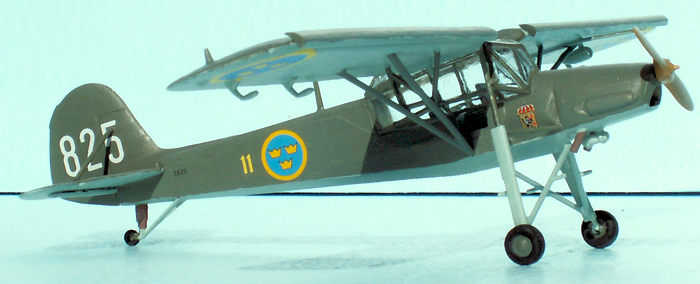 Anyway, all
existing Aists were destroyed by a German attack in 1941. No Aist survived. The
Aist did not have the same extraordinary STOL characteristics as the original
Storch. In return it had increased load capacity and a much greater range. The
Aist was modified for the conditions in the Soviet Union. Antonov’s first design
after the war, the AN-2 also had impressive STOL capabilities, even if it was a
large and clumsy biplane. Antonov had learned about high –lift devices from the
Storch, just like the Danish aircraft designer Viggo Kramme, see
here. The AN-2 was produced in huge numbers over a
long period, and many are flying today with the air forces of countries of the
former Warsaw Pact.
Anyway, all
existing Aists were destroyed by a German attack in 1941. No Aist survived. The
Aist did not have the same extraordinary STOL characteristics as the original
Storch. In return it had increased load capacity and a much greater range. The
Aist was modified for the conditions in the Soviet Union. Antonov’s first design
after the war, the AN-2 also had impressive STOL capabilities, even if it was a
large and clumsy biplane. Antonov had learned about high –lift devices from the
Storch, just like the Danish aircraft designer Viggo Kramme, see
here. The AN-2 was produced in huge numbers over a
long period, and many are flying today with the air forces of countries of the
former Warsaw Pact.
Finally, I shall mention another Storch inspired aircraft. In 1966, I visited Yugoslavia, and not far from Ljubljana, I came across a small airfield, where I took a photo of a pair of Fieseler Storchs, one with military markings, the other with a civil registration. 50 years later, I realized that the aircraft on my photo were not Storchs. They were Ikarus Kurir (courier), designed and built in the Serbian part of Yugoslavia, namely in Belgrade. The aircraft was produced in the second half of the fifties for the Yugoslavian Army and Air Force. All together 145 aircraft were produced, and they were in service until 1972, when the surviving aircraft were sold to civilians.
The Kurir was an all metal airplane, except the tail unit, which was fabric covered metal frames. The engine was a 155 hp DM-6R air cooled 6 cylinder inverted in line and geared, meaning that the propeller was offset to the starboard. The Kurir is slightly larger than the Storch, and does not have the long stalky landing gear legs. The fin and rudder is taller and more angular. There is currently no kit on the market of this interesting aircraft of Serbian design, as far as I know.
| THE KITS |
The Heller kit comes in a plastic bag with a zip lock. The instructions is especially for a Swedish Storch. There is a single large exploded sketch supposed to show how to put the model together. However, it does not solve all problems. There are two large sprues in a white styrene and a clear sprue with the canopy parts, the green house. The decal sheet is from RBD and has 11 options: 2 Norwegian, 2 Finnish, and 7 Swedish aircraft. The quality is first class, and the fine decals make you want to build a couple of Storchs more, one from Norway and one from Finland, too. A folded A 4 sheet in full color show the 11 options in side views, and on page 4 there is a drawing of a Finnish Storch as seen from above, and Norwegian wings showing the position of the national markings. There are color references in FS numbers for Finnish and Norwegian Storchs.
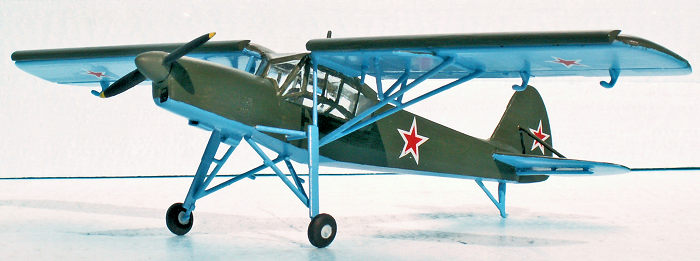 The Amodel
OKA Aist comes in a box with an Aist on the lid, probably the prototype. There
are four sprues in a medium grey styrene and a clear sprue with the green house.
The instructions is two A4 sheets. On page one there is a drawing of an Aist, a
very brief history in Russian and English, the symbols used in the assembly
steps are explained, and a color guide with references for Humbrol colors. Page
two shows the sprues with numbers of the parts, and steps 1-3 for the assembly.
Page three shows steps 4-6 and a side view for the colors. Page four, shows two
three view drawings showing the painting and decaling of the two options. The
small decal sheet has six red stars, with and without a white outline, and the
number 0-1, probably the marking of the prototype. The decals are of a fair
quality and easy to apply. However, the carrier film is rather thin, and there
is a risk of cracking the stars, if you are not careful enough.
The Amodel
OKA Aist comes in a box with an Aist on the lid, probably the prototype. There
are four sprues in a medium grey styrene and a clear sprue with the green house.
The instructions is two A4 sheets. On page one there is a drawing of an Aist, a
very brief history in Russian and English, the symbols used in the assembly
steps are explained, and a color guide with references for Humbrol colors. Page
two shows the sprues with numbers of the parts, and steps 1-3 for the assembly.
Page three shows steps 4-6 and a side view for the colors. Page four, shows two
three view drawings showing the painting and decaling of the two options. The
small decal sheet has six red stars, with and without a white outline, and the
number 0-1, probably the marking of the prototype. The decals are of a fair
quality and easy to apply. However, the carrier film is rather thin, and there
is a risk of cracking the stars, if you are not careful enough.
The Aist is almost identical to the Storch. The tail planes and the fin and rudder are slightly different, and the Renault engine is considerably longer than the Argus engine. There is a large spinner. It is fair to say, that the Aist is a long nosed Storch, just like the difference between a Fw 190 A and D!
| CONSTRUCTION |
Fieseler Fi-156 Storch.
In this case, you cannot just follow the instructions, because all you have got is a single exploded sketch. Hence, it is up to you, how to assemble the model. The only problem is assembling the green house. There are two ways to do this: 1) Use the roof as a base for building up the green house. This method may imply problems to make the green house fit properly into the recess of the assembled fuselage. 2) Glue the side parts of the green house to the assembled fuselage, and then glue the roof in place. This method may imply a problem to make the roof fit properly. I used the second alternative, and I had to sand the roof a lot to make it fit properly. The roof was too wide to the rear, about 1.5 mm.
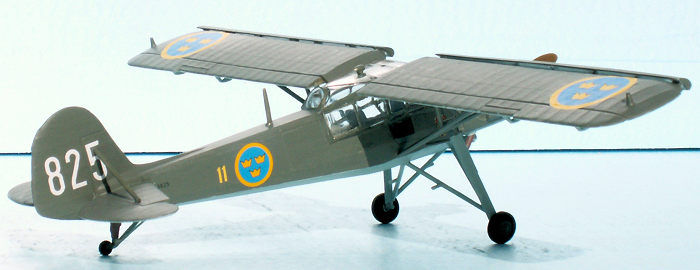 Before you
glue the roof in place, be sure the wings slip easily in place on the oblique
pins of the roof. The fixed leading edge slats must be sanded a lot, since they
do not have the right profile. They are too thick and clumsy. The slats are not
easy to glue properly in place. There is no support to secure the correct angle.
I used small pieces of plastic board and tape to create a reasonable angle for
the slats.
Before you
glue the roof in place, be sure the wings slip easily in place on the oblique
pins of the roof. The fixed leading edge slats must be sanded a lot, since they
do not have the right profile. They are too thick and clumsy. The slats are not
easy to glue properly in place. There is no support to secure the correct angle.
I used small pieces of plastic board and tape to create a reasonable angle for
the slats.
When the wings are glued in place, this should be done upside down, and each wing clamped in three places to a piece of plywood to make sure, the wings are strictly horizontal. The long landing gear oleos may cause problems, because it is necessary to glue three parts together in five different places simultaneously. However, this is possible, because it takes a long time before the glue has set, and it is possible to make small corrections to get everything quite right in place. It is a good idea to start with the small V support on the fuselage. This part should have a 5 degrees dihedral as seen from the front. These V supports are important for the correct angle of the oleo leg.
The tail wheel/runner leg is too short and should be lengthened by 5 mm, and the support should be almost twice as long. The slats of the tail planes need a clamp to be fixed correctly. The tail plane supports might be glued in place as the last item, if the decals used will be more or less covered by the supports.
There is
a special procedure for fixing the propeller to the engine front, a hot small
screwdriver will melt the
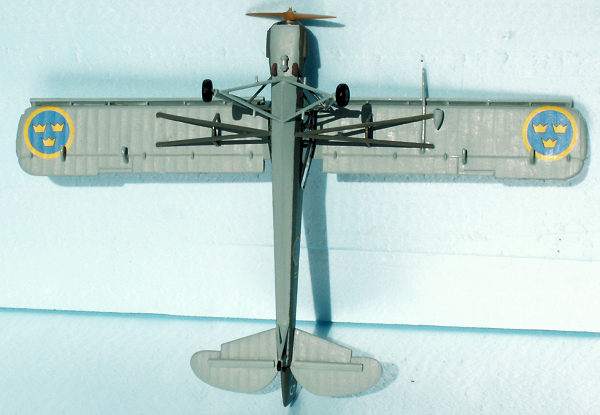 end of the
small plastic shaft, and secure the propeller not to fall off. This was a common
trick at the time, the kit was released for the first time. However, it works!
end of the
small plastic shaft, and secure the propeller not to fall off. This was a common
trick at the time, the kit was released for the first time. However, it works!
The finished model does definitely look like a Fieseler Storch. Of course all supports and landing gear is out of scale, concerning thickness. Actually, these parts are almost as thick, as the same parts for a 1/32 model!
Antonov OKA-38 Aist:
If you follow the instructions, you will end up with a nice model of an Aist –the long nosed Storch. The kit should be assembled just like the Heller kit. The engine front and the propeller are a little more advanced. However, the holes in part 5 and 9 are too narrow and should be drilled out, and part 9 does not fit into part 8.
The assembly of the green house is the same procedure as with the Storch. The flat roof has a step to the rear, which should not be there, a flaw of the kit. However, I did not do anything about it. You can use the alternative roof and avoid the problem.
The landing gear parts and the wing struts fit very well. The tail plane supports are a little too long (0.5 mm) and must be sanded a little. The tail runner is too short by 3 mm.
The finished model looks like a long nosed Storch with “wrong” tail planes, fin and rudder.
| COLORS & MARKINGS |
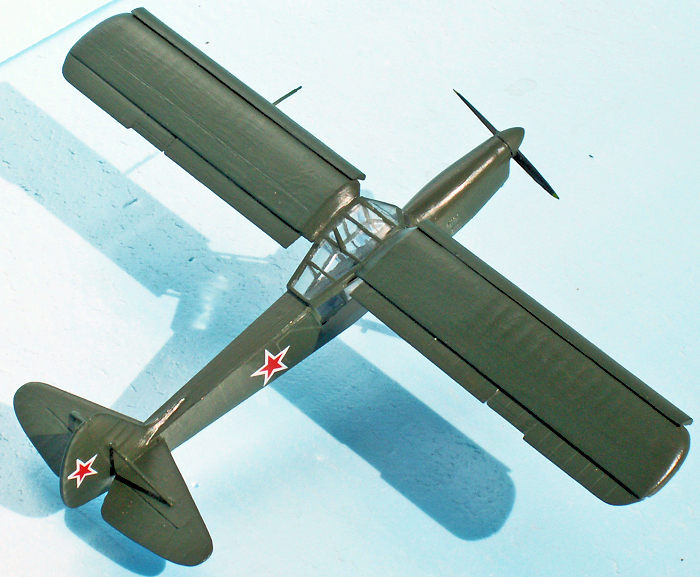 Fieseler
Storch S 14 B:
Fieseler
Storch S 14 B:
The standard color scheme of a Swedish S 14 B is dark green RLM 71 on the upper side and, the fuselage sides, and the wing struts. The underside, including wheel support and oleo and tail wheel support, is light blue grey, RLM 65. The propeller is wood, or dark green, and the tail wheel leg is leather. The tires are matt black and the exhausts are gun metal + rust. I used the decals from RBD/Hobby Center Helsingborg for the 3825 of the F 11 wing. After the large white 825 was in place on the fin and rudder, it was time to glue the tail plane supports in place using clear varnish as glue.
Antonov OKA-38 Aist:
The colors of the Aist are according to instructions: Upper sides, fuselage sides and spinner dark green, HB 30, and underside including landing gear legs and supports and struts is light blue, HB 65. Tires and propeller are matt black with yellow tips. The decaling is very simple: just six stars outlined in white. No stars on the upper side of the wing. One star on the fuselage behind the green house and one on the rudder.
| CONCLUSIONS |
Conclusions: The old Heller kit combined with the fine decal sheets from RBD with options for 11 Nordic aircraft was a temptation, I could not resist! 50 years ago, I built the ancient Airfix kit of the Storch with a German desert color scheme. The Heller kit has not the shortcomings of the Airfix kit, and it is recommendable to all modelers who fancy small transport aircraft. One year ago, I realized about the Amodel of the Russian Storch copy, and I was curious enough to buy the kit and model this rather unique aircraft. The Amodel kit is recommended for modelers, who want to add a long nosed Storch to their collection.
| REFERENCES |
Profile Publications: Aicraft Profile 228 Fieseler Fi-156 Storch by Richard P Bateson.
Wikipedia article: Fi-156 Storch, where the Russian copy is mentioned.
Bo Widfeldt: The Luftwaffe in Sweden 1939-1945. Monogram Aviation Publications, Boylston Mass. ISBN 0-91414
This book deals with every Luftwaffe aircraft on Swedish soil/waters during WWII. An impressive work of the author, Bo Widfeldt! There are a couple of hundred original photos, however not all to a professional standard. There are 15 color profiles of the following types: He-111 P, Do-17 P, Bf-109 E, DC-3, Fi-156 D, HS-126 B, AR-196 A, Fw-189 A, Fw-190 A 8, Bf-110 G 10, Ju-52/3m, Ju-88 G 6, Bf-109 G 10, Bf-109 G 10/R3 and Bf-110 G.
A rather special story was about a Danish Mechanic, Per Hiul. He stole a He-111 G from the Luftwaffe Base Kastrup, flew the aircraft to Helsingborg, where Swedish AA batteries shot the aircraft down. Shortly before the impact, Per Hiul hurried to the rear in the aircraft. The He- 111 was totally destroyed at the landing, however, Per hiul survived only slightly injuried. The rear part of the aircraft was torn off almost intact, and that fact saved Per Hiul’s life. The story is incredible, because Mr. Hiul did not have any flying training! The He-111 G was coded CE + NX and the unit was Blind Flug Schule 4, Blind flying School 4.
Svenska Vingar 1 by Bo Widfeldt and Åke Hall, Air Historic Research AB –Näässjö, ISBN 91-971605-3-9
This is an encyclopedia dealing with all Swedish military aircraft and helicopters from 1911 to 1999.
3 November 2020 Copyright
ModelingMadness.com If you would like your product reviewed fairly and fairly quickly, please
contact the editor
or see other details in the
Note to
Contributors.
Back to the Main Page
Back to the Review
Index Page
Back to the Previews Index Page